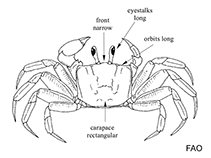Gelasimus vocans (Linnaeus, 1758)
Orange fiddler crab
Upload your photos
Google image | No image available for this species;
drawing shows typical species in Ocypodidae.
Google image | No image available for this species;
drawing shows typical species in Ocypodidae.
Classification / Names Common names | Synonyms | CoL | ITIS | WoRMS
Malacostraca | Decapoda | Ocypodidae
Environment: milieu / climate zone / depth range / distribution range Ecology
Benthic; brackish. Tropical; 30°N - 34°S, 30°E - 171°W
Distribution Countries | FAO areas | Ecosystems | Occurrences | Introductions
Indo-West Pacific: From East Africa to Samoa, Red Sea to Natal and Okinawa, Japan to subtropical Australia.
Length at first maturity / Size / Weight / Age
Maturity: Lm ? range ? - ? cm
Associated with muddy habitats in lagoonal beach (Ref. 104858). Also on muddy-sandy tidal flats (Ref. 104857). Reported to form droves (Ref. 104860). Feeds on emerged sand and in shallow water along the shoreline and in pools. Makes sand pellets while feeding to separate edible from inedible fractions (Ref. 104857).
Life cycle and mating behavior Maturity | Reproduction | Spawning | Eggs | Fecundity | Larvae
Members of the order Decapoda are mostly gonochoric. Mating behavior: Precopulatory courtship ritual is common (through olfactory and tactile cues); usually indirect sperm transfer.
Main reference
References | Coordinator | Collaborators
Walker, A.O. 1887. (Ref. 77883)
IUCN Red List Status (Ref. 130435)
CITES status (Ref. 108899)
Not Evaluated
CMS (Ref. 116361)
Not Evaluated
Threat to humans
Harmless
Human uses
| FishSource |
Tools
More information
Age/Size
Growth
Length-weight
Length-length
Morphology
Larvae
Abundance
Growth
Length-weight
Length-length
Morphology
Larvae
Abundance
Internet sources
BHL | BOLD Systems | CISTI | DiscoverLife | FAO(Publication : search) | Fishipedia | GenBank (genome, nucleotide) | GloBI | Gomexsi | Google Books | Google Scholar | Google | PubMed | Tree of Life | Wikipedia (Go, Search) | Zoological Record
Estimates based on models
Preferred temperature
(Ref. 115969): 27.8 - 29.3, mean 28.8 (based on 1849 cells).



